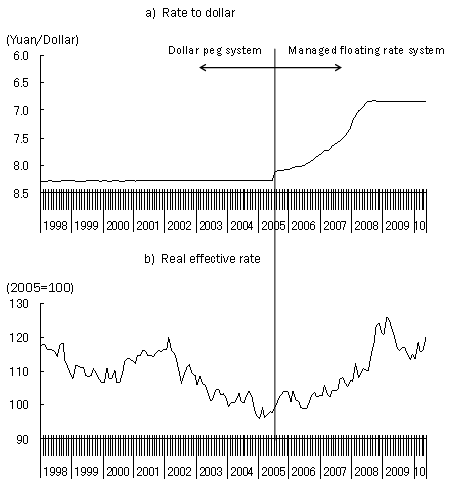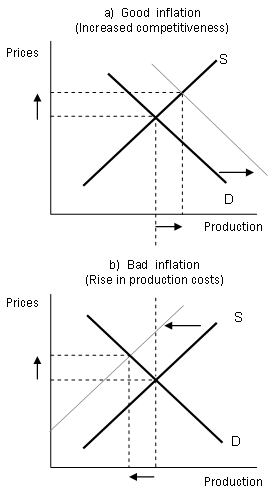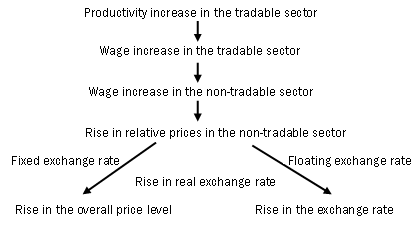On June 19, the People's Bank of China (the central bank) announced a policy of adopting a more flexible exchange rate for the yuan as part of its measures to improve the exchange rate mechanism. It subsequently resumed the revaluation of the yuan, by terminating the de facto dollar peg system that had been in place since July 2008. In recent years, rising exports from China, which capitalize on low wages, have been blamed for causing deflation in Japan, and it is hoped that a revaluation of the yuan will help to eliminate the problem. However, given that the economic structures of Japan and China are complementary rather than competitive, any inflation generated in China in association with a revaluation of the yuan is more likely to result in a rise in production costs for Japanese products rather than an increase in their competitiveness, with adverse effects on the Japanese economy.
Shift from made-in-China deflation to made-in-China inflation
In retrospect, the turning point from made-in-China deflation to made-in-China inflation goes back to July 2005, when the exchange rate of the yuan moved from the managed floating rate system to the dollar peg system. Since then, the real effective exchange rate of the yuan has reversed the downward trend of earlier times and has continued to rise, even after July 2008 when China returned to the dollar peg ( figure 1 ). This is because China has been entering the stage of full employment (the so-called Lewisian Turning Point) in its development process ( box ).
Figure1 : The Chinese yuan on the rise

(Source) Rate to dollar is based on State Administration of Foreign Exchange. Real effective rate is based on BIS.
As China has long had excess labor, any increase in productivity has resulted in a fall in product prices rather than a rise in wages. As a consequence, cheap Chinese products flooded world markets and triggered deflation. However, recent years have seen a rapid shift from a surplus of labor to a shortage, reflecting the depletion of excess labor power in rural areas. This has been accelerating wage increases and, in turn, inflation. To rein in inflation, the Chinese authorities have to accept a revaluation of the yuan. Either through inflation or through a revaluation of the yuan, prices of Chinese products will rise in foreign currency terms, turning made-in-China deflation to made-in-China inflation.
Good inflation vs. bad inflation
As China is not only Japan's largest export market but also the largest supplier of imports, a stronger yuan will put inflationary pressure on Japan. However, this will not necessarily lead to an expansion of production. Here, let us discuss the impact that made-in-China inflation will have on Japan, by dividing it into "good inflation," which will expand production, and "bad inflation," which will cause a contraction of production.
It goes without saying that Japan is hoping for good inflation. That is, if prices of Chinese exports rise, demand will shift from Chinese products to Japanese products, not only in Japan but also in third countries. This will drive up prices as well as production in Japan ( figure 2a ).
However, there is a negative aspect to the inflation emerging from China. For Japanese companies that import components and intermediate goods from China, a rise in import prices from China due to a revaluation of the yuan would mean a rise in production costs on the supply side. In such a case, although prices would rise in Japan, production would decline ( figure 2b ).
Figure2 : Made-in China Inflation
- Impact on Japan (advanced economies) -

(Source) Prepared by Chi Hung KWAN
Stronger yuan to bring bad inflation to Japan
For Japan, conclusions about which type of inflation (good or bad) stemming from a revaluation of the yuan will have a larger impact on Japan depends on whether the economic relationship between Japan and China is competitive or complementary. If the economic relationship is competitive, the effect on the demand side will be larger, and the positive impact on production will be stronger. In contrast, if it is complementary, the effect on the supply side will be larger, and the negative impact on production will be stronger.
In fact, it is clear that the economies of both countries are in a complementary relationship, with the export structure of Japan centered on high value-added, high-tech products while that of China is concentrated on low value-added, low-tech products. As a consequence, even if the yuan appreciates, the shift in demand from Chinese products to Japanese products will not be significant, and a more likely result will be that higher import costs will lead to a contraction of production in Japan.
The revaluation of the yuan will have an impact on the Japanese economy not only through the price effect but also courtesy of the income effect. Although it is true that a stronger yuan will lead to an increase in both real incomes for Chinese consumers and demand for Japanese products, it will also have the effect of slowing Chinese exports, which will in turn result in a decrease in the imports of intermediate goods from Japan. Given that the two effects will balance out, the impact of the income effect associated with a stronger yuan on the Japanese economy is expected to be more or less neutral.
When combining the price effect and income effect, it is clear that a revaluation of the yuan will not necessarily contribute to an economic recovery in Japan. The same logic also applies to the United States and other developed nations that are in the same kind of complementary relationship with China.
Stronger yuan not a factor for a stronger yen
The revaluation of the yuan will have an impact on prices and production as well as interest rates and exchange rates in major economies. As long as a stronger yuan becomes a trigger to turn made-in-China deflation to made-in-China inflation, it will become a factor to push up interest rates in developed nations that import a large quantity of Chinese products. In particular, a revaluation of the yuan means that the exchange rate will approach its equilibrium level, so that the scale of intervention in foreign exchange markets to sell yuan and buy U.S. dollars will diminish compared to the time when the yuan was not revalued. In keeping with this, the rise in foreign exchange reserves of China and, in turn, the purchase of U.S. Treasury bonds will be curbed. As a result, the rise in interest rates in the United States will be larger than it will be in other developed countries such as Japan. If funds flow into dollar-denominated assets from yen-denominated assets, reflecting a wider gap in interest rates between the United States and Japan, it should be understood that the stronger yuan will rather be a factor for a stronger dollar and weaker yen, contrary to the conventional wisdom of the market, in which the yen strengthens with the yuan.
BOX: Balassa-Samuelson Effect Pronounced When Full Employment Achieved
As implied by the Balassa-Samuelson hypothesis, which appears in international economics textbooks, there is a general tendency for the exchange rate of a fast-growing country to rise. This reflects the fact that differences in the rate of increase in productivity between the tradable sector centering on manufacturing and the non-tradable sector centering on services tends to be larger in a country with high growth than in a country with lower growth.
Figure : Balassa-Samuelson hypothesis

(Source) Prepared by Chi Hung KWAN
More specifically, for a country with high growth, the rate of increase in productivity is high in the tradable sector (e.g. the electronics industry), and wages will rise at a pace concomitant with the rate of increase in productivity. Premised on the common domestic labor market, however, the wage level in the non-tradable sector (e.g. barbers) will also rise to a level in line with that of the tradable sector, even if the productivity in the non-tradable sector does not increase to the same extent as it does in the tradable sector, because an arbitrage relationship is at work with wages. As a result, prices of non-tradable goods will become high, relative to those of tradable goods.
A rise in prices of non-tradable goods relative to those of tradable goods will cause a rise in the real exchange rate through one of the following channels. First, in the case of a fixed exchange rate system, purchasing power parity (PPP) comes into effect in tradable goods. Therefore, provided that prices overseas are given, prices of tradable goods remain unchanged, but changes in relative prices will emerge in the form of a rise in service prices and, in turn, a rise in overall prices. If the government cannot accept inflation, it must respond to the rise in overall prices by revaluing the exchange rate. In this case, the exchange rate will rise, instead of prices. In either case, the real exchange rate will climb.
The Balassa-Samuelson hypothesis was often used to explain the stronger yen observed from the 1970s through the 1990s. In China, by contrast, reflecting the enormous labor redundancies in rural areas, an increase in productivity in the tradable sector did not necessarily result in the expected wage increase. Therefore, despite the high economic growth, an upward trend in the yuan was not observed in either nominal or real terms over the long term. However, as China is passing through the Lewisian Turning Point, which means the achievement of full employment, the yuan is becoming stronger in line with the high growth, as maintained by the Balassa-Samuelson hypothesis.


